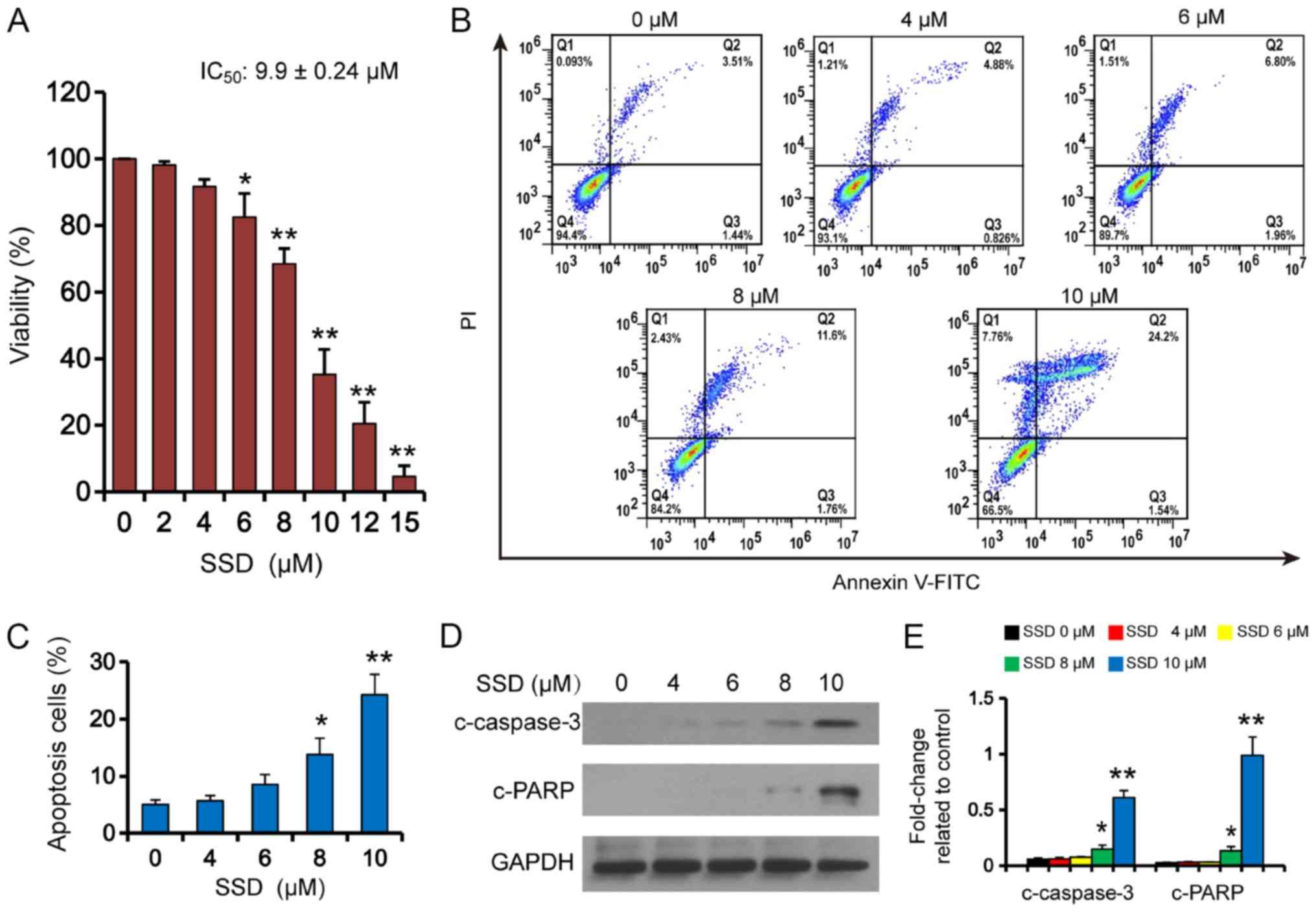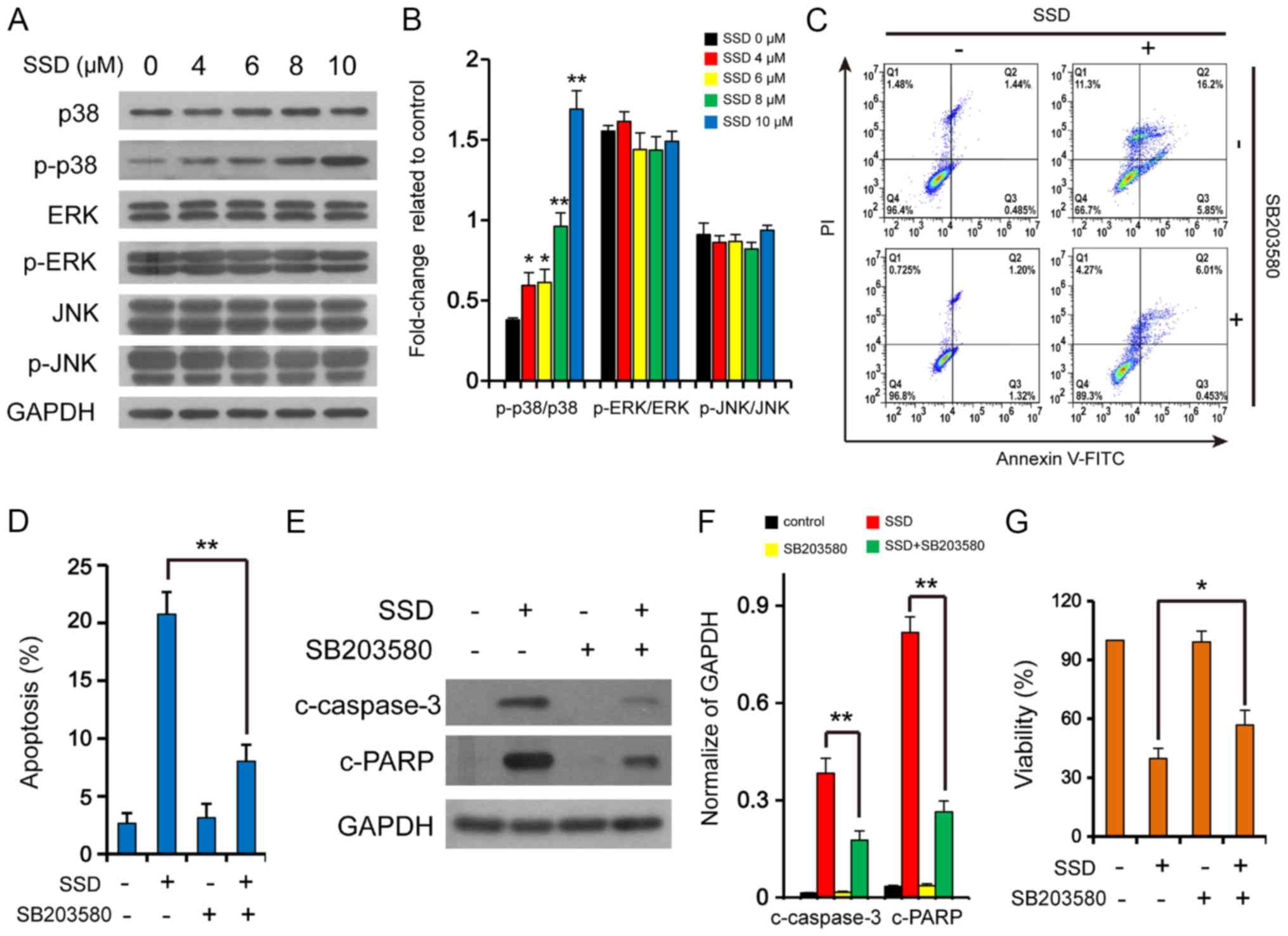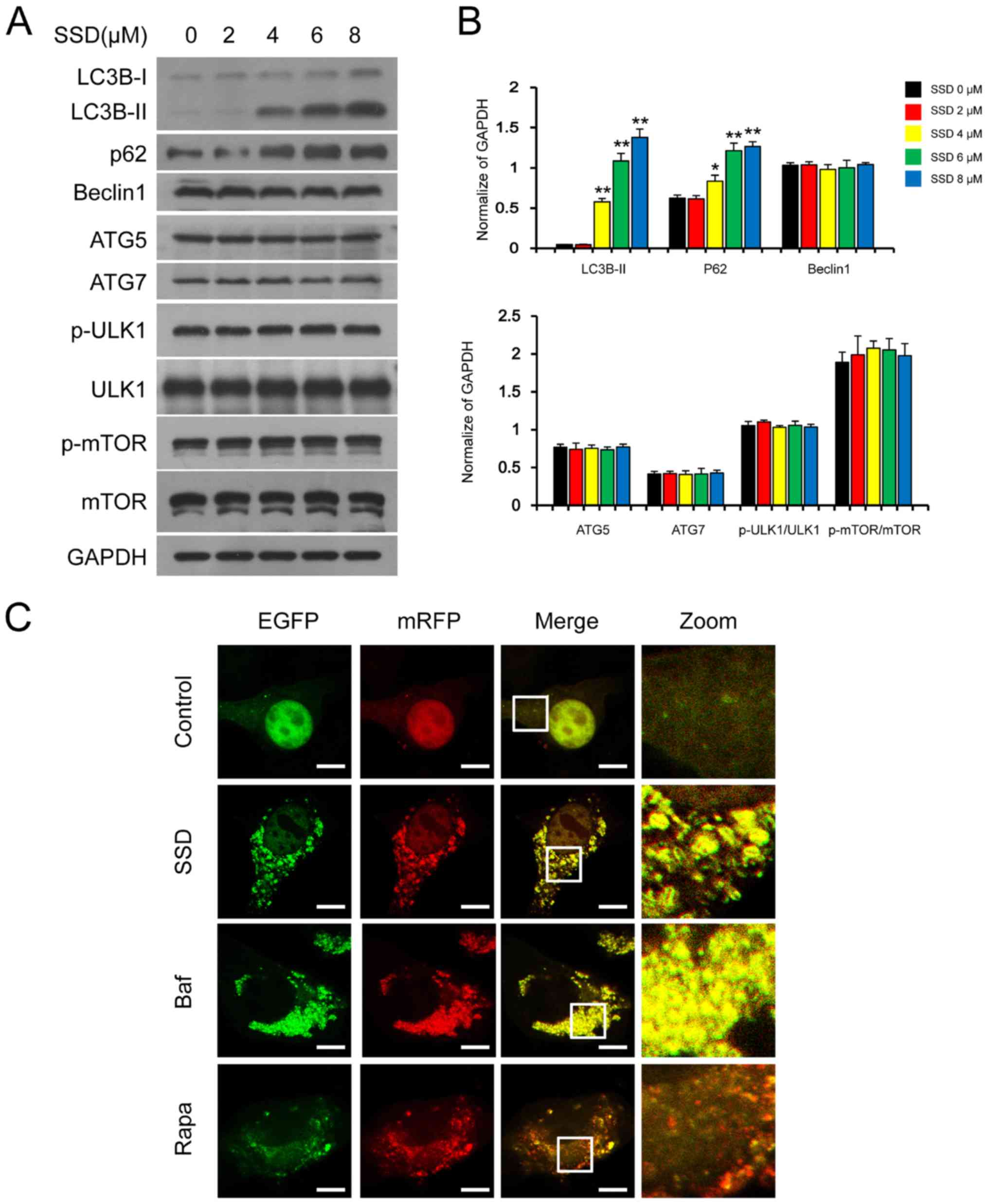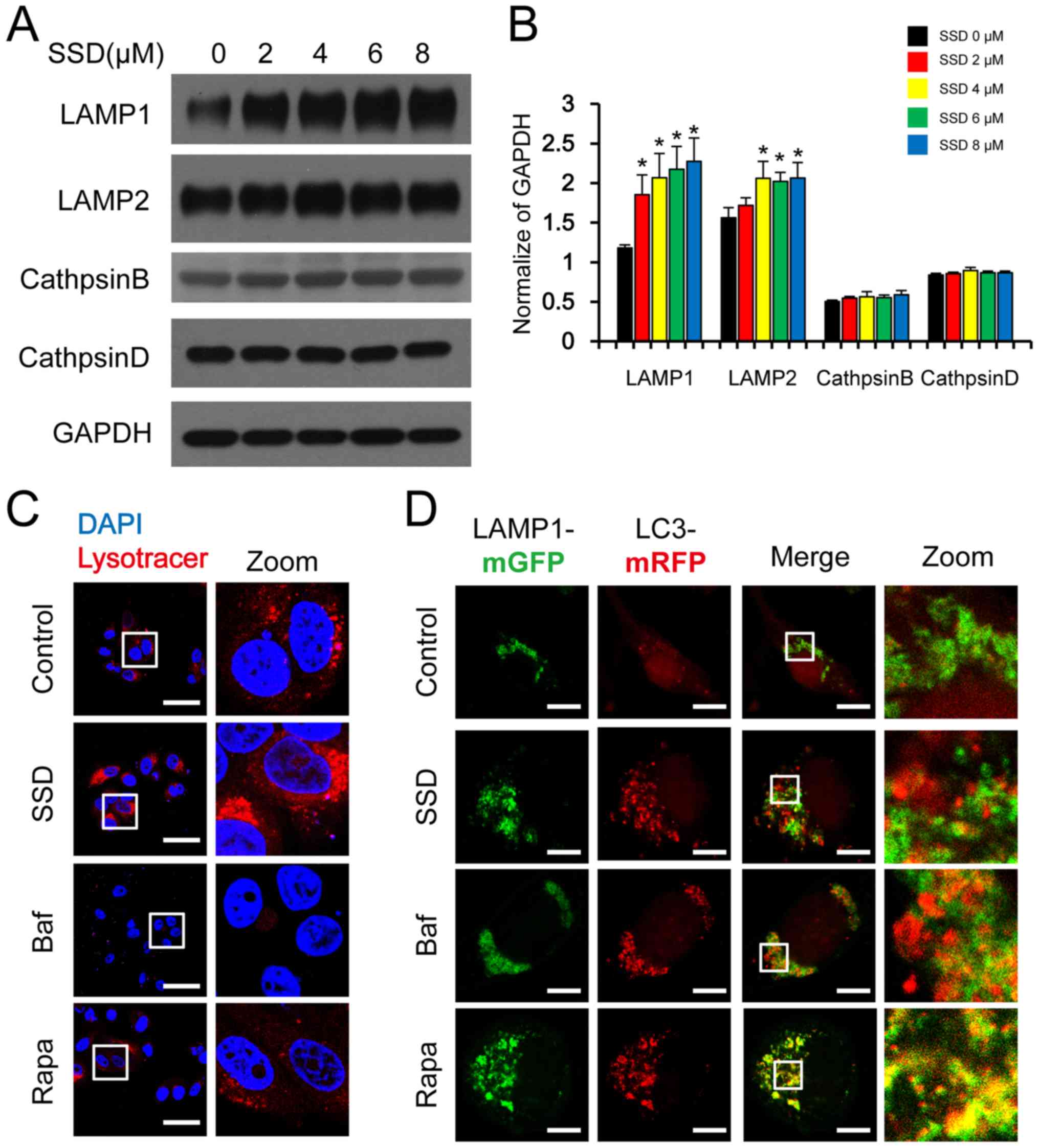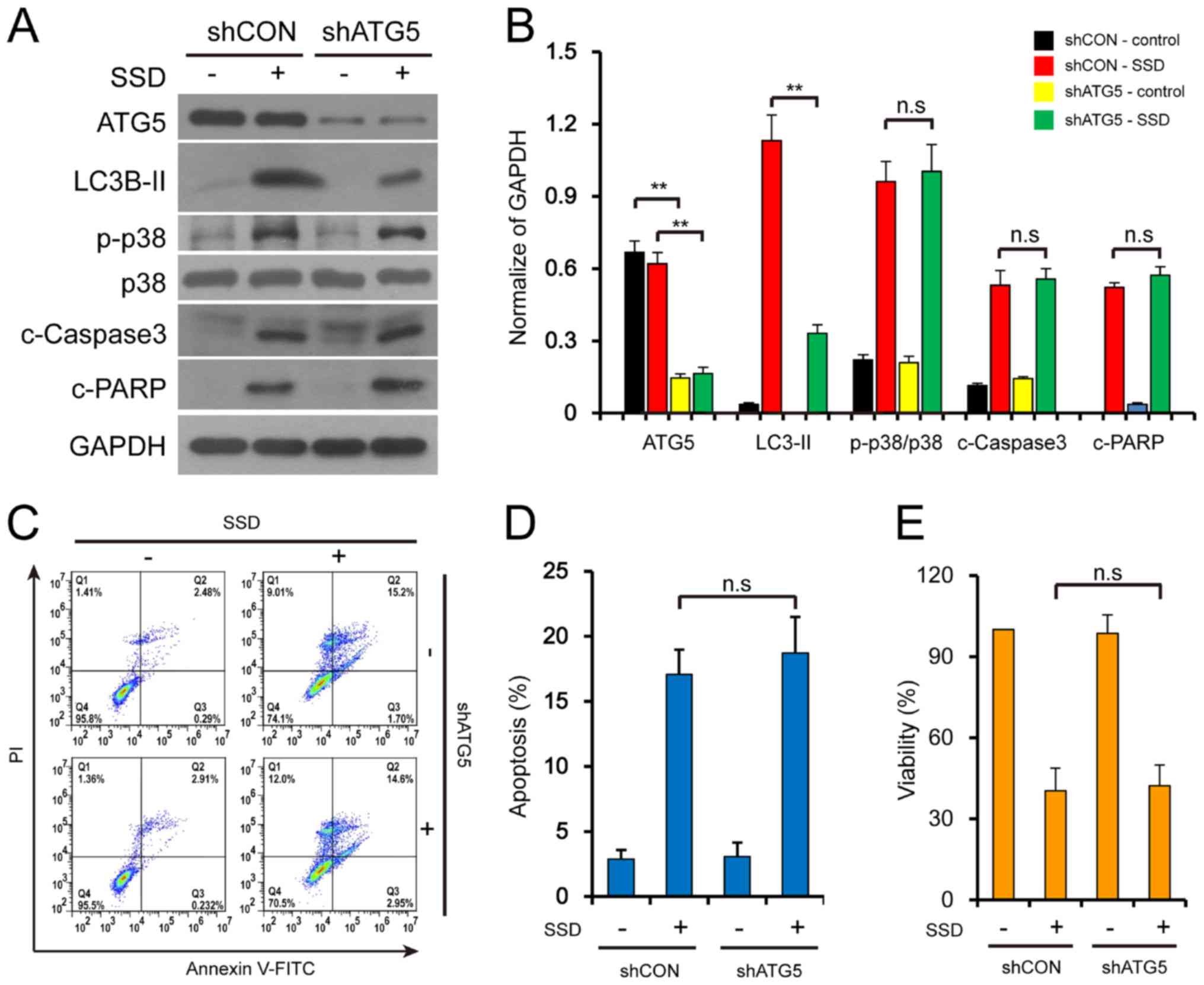|
1
|
Yin Z, Pascual C and Klionsky DJ:
Autophagy: Machinery and regulation. Microb Cell. 3:588–596. 2016.
View Article : Google Scholar : PubMed/NCBI
|
|
2
|
Bostancıklıoğlu M: An update on the
interactions between Alzheimer's disease, autophagy and
inflammation. Gene. 705:157–166. 2019. View Article : Google Scholar : PubMed/NCBI
|
|
3
|
Jiang X, Overholtzer M and Thompson CB:
Autophagy in cellular metabolism and cancer. J Clin Invest.
125:47–54. 2015. View
Article : Google Scholar : PubMed/NCBI
|
|
4
|
White E: The role for autophagy in cancer.
J Clin Invest. 125:42–46. 2015. View
Article : Google Scholar : PubMed/NCBI
|
|
5
|
Levy JMM, Towers CG and Thorburn A:
Targeting autophagy in cancer. Nat Rev Cancer. 17:528–542. 2017.
View Article : Google Scholar : PubMed/NCBI
|
|
6
|
Chude CI and Amaravadi RK: Targeting
autophagy in cancer: Update on clinical trials and novel
inhibitors. Int J Mol Sci. 18:12792017. View Article : Google Scholar
|
|
7
|
Zhou J, Li G, Zheng Y, Shen HM, Hu X, Ming
QL, Huang C, Li P and Gao N: A novel autophagy/mitophagy inhibitor
liensinine sensitizes breast cancer cells to chemotherapy through
DNM1L-mediated mitochondrial fission. Autophagy. 1:1259–1279. 2015.
View Article : Google Scholar
|
|
8
|
Zhou J, Hu SE, Tan SH, Cao R, Chen Y, Xia
D, Zhu X, Yang XF, Ong CN and Shen HM: Andrographolide sensitizes
cisplatin-inducedapoptosis via suppression of autophagosome
lysosome fusion in human cancer cells. Autophagy. 8:338–349. 2012.
View Article : Google Scholar : PubMed/NCBI
|
|
9
|
Stamenkovic M, Janjetovic K, Paunovic V,
Ciric D, Kravic-Stevovic T and Trajkovic V: Comparative analysis of
cell death mechanisms induced by lysosomal autophagy inhibitors.
Eur J Pharmacol. 859:1725402019. View Article : Google Scholar : PubMed/NCBI
|
|
10
|
Yang YY, Tang YZ, Fan CL, Luo HT, Guo PR
and Chen JX: Identification and determination of the saikosaponins
in Radix bupleuri by accelerated solvent extraction combined
with rapid-resolution LC-MS. J Sep Sci. 33:1933–1945. 2010.
View Article : Google Scholar : PubMed/NCBI
|
|
11
|
Tsuyoshi H, Wong VKW, Han Y, Orisaka M,
Yoshida Y and Tsang BK: Saikosaponin-d, a calcium mobilizing agent,
sensitizes chemoresistant ovarian cancer cells to cisplatin-induced
apoptosis by facilitating mitochondrial fission and G2/M arrest.
Oncotarget. 8:99825–99840. 2017. View Article : Google Scholar : PubMed/NCBI
|
|
12
|
Chen X, Liu C, Zhao R, Zhao P, Wu J, Zhou
N and Ying M: Synergetic and antagonistic molecular effects
mediated by the feedback loop of p53 and JNK between Saikosaponin D
and SP600125 on lung cancer A549 cells. Mol Pharm. 15:4974–4984.
2018. View Article : Google Scholar : PubMed/NCBI
|
|
13
|
Chun YZ, Zhong MJ, Xiao FM, Yue L, Xiao
ZL, Li LL, Wen HW and Tao W: Saikosaponin-d inhibits the hepatoma
cells and enhances chemosensitivity through SENP5-dependent
inhibition of Gli1 SUMOylation under hypoxia. Front Pharmacol.
10:1039–1052. 2019. View Article : Google Scholar : PubMed/NCBI
|
|
14
|
Li Y, Cai T, Zhang W, Zhu W and Lv S:
Effects of Saikosaponin D on apoptosis in human U87 glioblastoma
cells. Mol Med Rep. 16:1459–1464. 2017. View Article : Google Scholar : PubMed/NCBI
|
|
15
|
Wong VK, Li T, Law BY, Ma ED, Yip NC,
Michelangeli F, Law CK, Zhang MM, Lam KY, Chan PL and Liu L:
Saikosaponin-d, a novel SERCA inhibitor, induces autophagic cell
death in apoptosis-defective cells. Cell Death Dis. 4:e7202013.
View Article : Google Scholar : PubMed/NCBI
|
|
16
|
Li C, Huang L, Sun W, Chen Y, He ML, Yue J
and Ballard H: Saikosaponin D suppresses enterovirus A71 infection
by inhibiting autophagy. Signal Transduct Target Ther. 4:42019.
View Article : Google Scholar : PubMed/NCBI
|
|
17
|
Sui X, Kong N, Ye L, Han W, Zhou J, Zhang
Q, He C and Pan H: p38 and JNK MAPK pathways control the balance of
apoptosis and autophagy in response to chemotherapeutic agents.
Cancer Lett. 344:174–179. 2014. View Article : Google Scholar : PubMed/NCBI
|
|
18
|
Yu RL, Yun JK, Myung HK and June MK: MAPK
cascades in guard cell signal transduction. Front Plant Sci.
7:80–87. 2016.PubMed/NCBI
|
|
19
|
Mizushima N, Yoshimori T and Ohsumi Y: The
role of Atg proteins in autophagosome formation. Annu Rev Cell Dev
Biol. 27:107–132. 2011. View Article : Google Scholar : PubMed/NCBI
|
|
20
|
Katsuragi Y, Ichimura Y and Komatsu M:
p62/SQSTM1 functions as a signaling hub and an autophagy adaptor.
FEBS J. 282:4672–4678. 2015. View Article : Google Scholar : PubMed/NCBI
|
|
21
|
Kimura S, Noda T and Yoshimori T:
Dissection of the autophagosome maturation process by a novel
reporter protein, tandem fluorescent-tagged LC3. Autophagy.
3:452–460. 2007. View Article : Google Scholar : PubMed/NCBI
|
|
22
|
Eskelinen EL: Roles of LAMP-1 and LAMP-2
in lysosome biogenesis and autophagy. Mol Aspects Med. 27:495–502.
2006. View Article : Google Scholar : PubMed/NCBI
|
|
23
|
Siong Tan HW, Anjum B, Shen HM, Ghosh S,
Yen PM and Sinha RA: Lysosomal inhibition attenuates peroxisomal
gene transcription via suppression of PPARA and PPARGC1A levels.
Autophagy. 15:1455–1459. 2019. View Article : Google Scholar : PubMed/NCBI
|
|
24
|
Colacurcio DJ and Nixon RA: Disorders of
lysosomal acidification-The emerging role of v-ATPase in aging and
neurodegenerative disease. Ageing Res Rev. 32:75–88. 2016.
View Article : Google Scholar : PubMed/NCBI
|
|
25
|
Woolbright BL, Ramachandran A, McGill MR,
Yan HM, Bajt ML, Sharpe MR, Lemasters JJ and Jaeschke H: Lysosomal
instability and cathepsin B release during acetaminophen
hepatotoxicity. Basic Clin Pharmacol Toxicol. 111:417–425. 2012.
View Article : Google Scholar : PubMed/NCBI
|
|
26
|
Miyagawa K, Oe S, Honma Y, Izumi H, Baba R
and Harada M: Lipid-induced endoplasmic reticulum stress impairs
selective autophagy at the step of autophagosome-lysosome fusion in
hepatocytes. Am J Pathol. 186:1861–1873. 2016. View Article : Google Scholar : PubMed/NCBI
|
|
27
|
Ren M, McGowan E, Li Y, Zhu X, Lu X, Zhu
Z, Lin Y and He S: Saikosaponin-d Suppresses COX2 through
p-STAT3/C/EBPβ signaling pathway in liver cancer: A novel mechanism
of action. Front Pharmacol. 10:6232019. View Article : Google Scholar : PubMed/NCBI
|
|
28
|
Gao T, Zhao P, Yu X, Cao S, Zhang B and
Dai M: Use of Saikosaponin D and JNK inhibitor SP600125, alone or
in combination, inhibits malignant properties of human osteosarcoma
U2 cells. Am J Transl Res. 11:2070–2080. 2019.PubMed/NCBI
|
|
29
|
Li C, Guan X, Xue H, Wang P, Wang M and
Gai X: Reversal of P-glycoprotein-mediated multidrug resistance is
induced by saikosaponin D in breast cancer MCF-7/adriamycin cells.
Pathol Res Pract. 213:848–853. 2017. View Article : Google Scholar : PubMed/NCBI
|
|
30
|
Wang J, Qi H, Zhang X, Si W, Xu F, Hou T,
Zhou H, Wang A, Li G, Liu Y, et al: Saikosaponin D from Radix
bupleuri suppresses triple-negative breast cancer cell growth
by targeting β-catenin signaling. Biomed Pharmacother. 108:724–733.
2018. View Article : Google Scholar : PubMed/NCBI
|
|
31
|
Cuadrado A and Nebreda AR: Mechanisms and
functions of p38 MAPK signalling. Biochem J. 429:403–417. 2010.
View Article : Google Scholar : PubMed/NCBI
|
|
32
|
Chen W, Tan Y and Zhang Y: p38 MAPK
signaling pathway activation by phenyl benzoxime in SNU-306 cells
causes induction of apoptosis. Microb Pathog. 126:74–78. 2019.
View Article : Google Scholar : PubMed/NCBI
|
|
33
|
Zhou Q, Wu X, Wen C, Wang H, Wang H, Liu H
and Peng J: Toosendanin induces caspase-dependent apoptosis through
the p38 MAPK pathway in human gastric cancer cells. Biochem Biophys
Res Commun. 505:261–266. 2018. View Article : Google Scholar : PubMed/NCBI
|
|
34
|
Gewirtz DA: The challenge of developing
autophagy inhibition as a therapeutic strategy. Cancer Res.
76:5610–5614. 2016. View Article : Google Scholar : PubMed/NCBI
|
|
35
|
Palmeira dos Santos C, Pereira GJ, Barbosa
CM, Jurkiewicz A, Smaili SS and Bincoletto C: Comparative study of
autophagy inhibition by 3MA and CQ on cytarabine-induced death of
leukaemia cells. J Cancer Res Clin Oncol. 140:909–920. 2014.
View Article : Google Scholar : PubMed/NCBI
|
|
36
|
Somya V and Ravi M: A reversible autophagy
inhibitor blocks autophagosome-lysosome fusion by preventing Stx17
loading onto autophagosomes. Mol Biol Cell. 30:2283–2295. 2019.
View Article : Google Scholar : PubMed/NCBI
|
|
37
|
Yu L, Wu WK, Gu C, Zhong D, Zhao X, Kong
Y, Lin Q, Chan MT, Zhou Z and Liu S: Obatoclax impairs lysosomal
function to block autophagy in cisplatin-sensitive and -resistant
esophageal cancer cells. Oncotarget. 7:14693–14707. 2016.
View Article : Google Scholar : PubMed/NCBI
|
|
38
|
Dong LL, Yang Y, Quan L and Jian JW:
Inhibition of autophagy by 3-MA potentiates cisplatin-induced
apoptosis in esophageal squamous cell carcinoma cells. Med Oncol.
28:105–111. 2011. View Article : Google Scholar : PubMed/NCBI
|
|
39
|
Mauvezin C and Neufeld TP: Bafilomycin A1
disrupts autophagic flux by inhibiting both V-ATPase-dependent
acidification and Ca-P60A/SERCA-dependent autophagosome-lysosome
fusion. Autophagy. 11:1437–1438. 2015. View Article : Google Scholar : PubMed/NCBI
|
|
40
|
Malicdan MC and Nishino I: Autophagy in
lysosomal myopathies. Brain Pathol. 22:82–88. 2012. View Article : Google Scholar : PubMed/NCBI
|
|
41
|
Man SM and Kanneganti TD: Regulation of
lysosomal dynamics and autophagy by CTSB/cathepsin B. Autophagy.
12:2504–2505. 2016. View Article : Google Scholar : PubMed/NCBI
|
|
42
|
Mauthe M, Orhon I, Rocchi C, Zhou X, Luhr
M, Hijlkema KJ, Coppes RP, Engedal N, Mari M and Reggiori F:
Chloroquine inhibits autophagic flux by decreasing
autophagosome-lysosome fusion. Autophagy. 14:1435–1455. 2018.
View Article : Google Scholar : PubMed/NCBI
|
|
43
|
Shimizu S, Yoshida T, Tsujioka M and
Arakawa S: Autophagic cell death and cancer. Int J Mol Sci.
15:3145–3153. 2014. View Article : Google Scholar : PubMed/NCBI
|
|
44
|
Zhang H, Ge S, He K, Zhao X, Wu Y, Shao Y
and Wu X: FoxO1 inhibits autophagosome-lysosome fusion leading to
endothelial-apoptosis in diabetes. Cardiovasc Res. 115:2008–2020.
2019. View Article : Google Scholar : PubMed/NCBI
|















